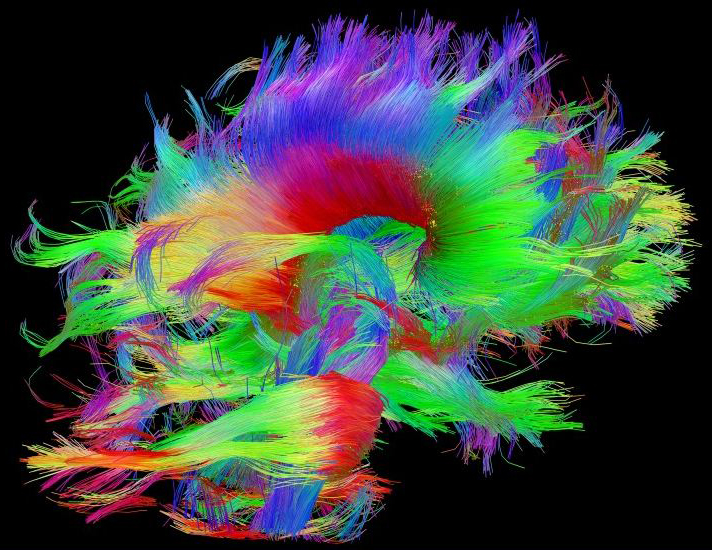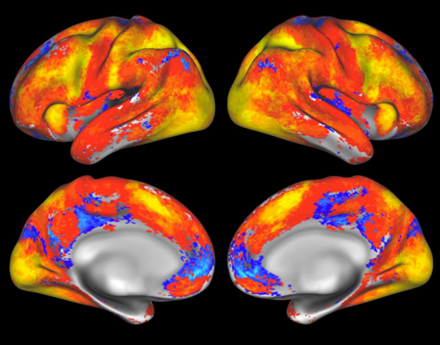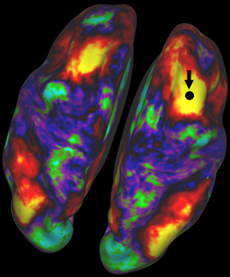NIH explains Brain Research through Advancing Innovative Neurotechnologies (BRAIN) initiative
April 5, 2013

(Credit: Human Connectome Project)
The National Institute of Health (NIH) has provided further details on the Brain Research through Advancing Innovative Neurotechnologies (BRAIN) Initiative announced April 2 by President Obama, aimed at revolutionizing our understanding of the human brain.
By accelerating the development and application of innovative technologies, researchers will be able to produce a revolutionary new dynamic picture of the brain that, for the first time, shows how individual cells and complex neural circuits interact in both time and space, the agency says.
Long desired by researchers seeking new ways to treat, cure, and even prevent brain disorders, this picture will fill major gaps in our current knowledge and provide unprecedented opportunities for exploring exactly how the brain enables the human body to record, process, utilize, store, and retrieve vast quantities of information, all at the speed of thought.
Why is the NIH BRAIN Initiative needed?

A map of overall task-fMRI brain coverage from the seven tasks used in the Human Connectome Project. Yellow and red represent regions that become more active in most participants during one or more tasks in the MR scanner; blue represents regions that become less active. (Credit: D.M. Barch for the WU-Minn HCP Consortium)
With nearly 100 billion neurons and 100 trillion connections, the human brain remains one of the greatest mysteries in science and one of the greatest challenges in medicine. Neurological and psychiatric disorders, such as Alzheimer’s disease, Parkinson’s disease, autism, epilepsy, schizophrenia, depression, and traumatic brain injury, exact a tremendous toll on individuals, families, and society.
Despite the many advances in neuroscience in recent years, the underlying causes of most of neurological and psychiatric conditions remain largely unknown, due to the vast complexity of the human brain. If we are ever to develop effective ways of helping people suffering from these devastating conditions, researchers will first need a more complete arsenal of tools and information for understanding how the brain functions both in health and disease.
Why is now the right time for the NIH BRAIN Initiative?

A map of the average “functional connectivity” in the human cerebral cortex collected on healthy subjects while “at rest” in the MRI scanner. Regions in yellow/red are functionally connected to the “seed” location (black circle, arrow), whereas regions in green and blue are weakly connected or not connected at all. (Credit: M. F. Glasser and S. M. Smith for the WU-Minn HCP consortium)
In the last decade alone, scientists have made a number of landmark discoveries that now create the opportunity to unlock the mysteries of the brain. We have witnessed the sequencing of the human genome, the development of new tools for mapping neuronal connections, the increasing resolution of imaging technologies, and the explosion of nanoscience.
These discoveries have yielded unprecedented opportunities for integration across scientific fields. For instance, by combining advanced genetic and optical techniques, scientists can now use pulses of light in animal models to determine how specific cell activities within the brain affect behavior.
What’s more, through the integration of neuroscience and physics, researchers can now use high-resolution imaging technologies to observe how the brain is structurally and functionally connected in living humans.
While these technological innovations have contributed substantially to our expanding knowledge of the brain, significant breakthroughs in how we treat neurological and psychiatric disease will require a new generation of tools to enable researchers to record signals from brain cells in much greater numbers and at even faster speeds.
This cannot currently be achieved, but great promise for developing such technologies lies at the intersections of nanoscience, imaging, engineering, informatics, and other rapidly emerging fields of science.
How will the NIH BRAIN Initiative work?
Given the ambitious scope of this pioneering endeavor, it is vital that planning for the NIH BRAIN Initiative be informed by a wide range of expertise and experience. Therefore, NIH is establishing a high level working group of the Advisory Committee to the NIH Director (ACD) to help shape this new initiative.
This working group, co-chaired by Dr. Cornelia “Cori” Bargmann (The Rockefeller University) and Dr. William Newsome (Stanford University), is being asked to articulate the scientific goals of the BRAIN initiative and develop a multi-year scientific plan for achieving these goals, including timetables, milestones, and cost estimates.
As part of this planning process, input will be sought broadly from the scientific community, patient advocates, and the general public. The working group will be asked to produce an interim report by fall 2013 that will contain specific recommendations on high-priority investments for Fiscal Year (FY) 2014. The final report will be delivered to the NIH Director in June 2014.
How will the NIH BRAIN Initiative be supported?
In total, NIH intends to allocate $40 million in FY14. Given the cross-cutting nature of this project, the NIH Blueprint for Neuroscience Research — an initiative spanning 14 NIH Institutes and Centers — will be the leading NIH contributor to its implementation in FY14.
Of course, a goal this audacious will require ideas from the best scientists and engineers across many diverse disciplines and sectors. Therefore, NIH is working in close collaboration with other government agencies, including the Defense Advanced Research Projects Agency (DARPA) and the National Science Foundation (NSF).
Strong interest has also been expressed by several private foundations, including the Howard Hughes Medical Institute, the Allen Institute for Brain Science, and The Kavli Foundation, and the Salk Institute for Biological Studies. Private industries have also expressed a high level of interest in participation in this groundbreaking initiative.
Five years ago a project such as this would have been considered impossible. Five years from now will be too late. While the goals are profoundly ambitious, the time is right to inspire a new generation of neuroscientists to undertake the most groundbreaking approach ever contemplated to understanding how the brain works, and how disease occurs.